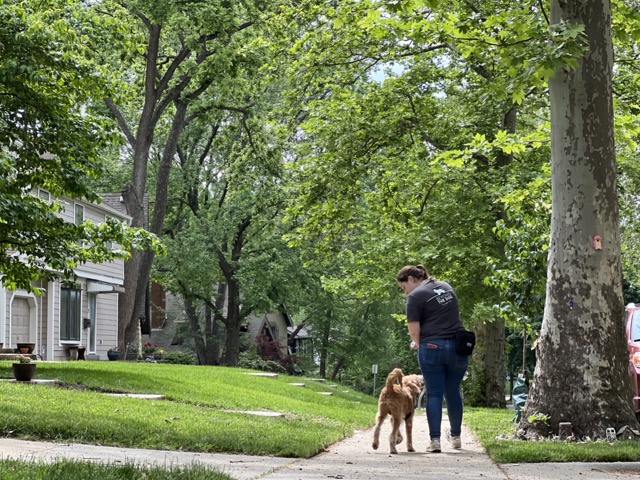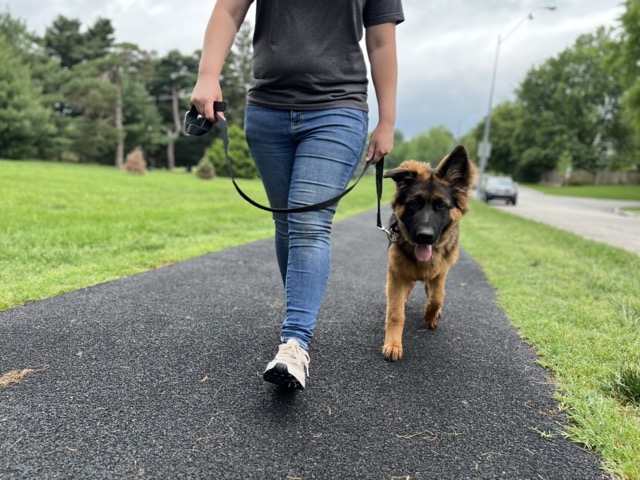In my practice, we work with owners to address a wide variety of puppy problem behaviors. In doing so, I rely on the words and observations of owners as well as a questionnaire I developed. With the development of the questionnaire, I have noticed certain behaviors are often interpreted incorrectly by owners, which is to be expected. After all, owners are well informed but are not experts and they are seeking help to solve the problem behavior. One of the topics that is often “misdiagnosed” is leash walking. Potential clients report their puppy having issues with leash walking and lacking a heel command when their concerns are indicators of more severe problem behaviors. Struggles with leash walking can be much more than a puppy not knowing the proper heel position. So, what does it mean, and how can I differentiate between them?
When is leash walking as simple as a puppy not knowing the heel command and when is it a sign of more severe problem behavior?

A puppy leash walking out of heel position and not knowing a proper heel command is expected and should not cause alarm for an owner. A heel command for a puppy is relatively easy to teach, and a lack of the command is not a sign of any larger problem behavior. The important point is to know how puppies typically behave on a leash so you know whether your puppy’s behavior is typical. Puppies generally wander or dart in various directions. They move in front of the handler and to the handler’s side. They may lag but quickly catch up, keeping pace with their owner. Young puppies tire easily but are exuberant during the first few minutes of the walk. None of these behaviors are alarming or concerning to me as a Certified Applied Animal Behaviorist. The solution for the bounding and weaving in various directions is easy. A choose-to-heel can be started for puppies under 16 weeks of age — some older puppies may also be responsive to this method. A more standard leash walking and heel can be started for puppies older than 16 weeks.
Signs of more severe problem behavior

Fear-related behavior
A more concerning leash walking issue I have seen in my practice is when a puppy stops and will not walk or follow an owner. They often flatten to the ground and are hesitant to walk out of the front door. In these instances, puppies remain behind the handler. There is often tension in the leash; in more extreme cases, puppies tremble and scan the environment nervously. these behaviors are often confusing because the puppy may seem otherwise friendly and carefree. What’s more is that the signs can be surprisingly subtle, particularly in our chaotic day-to-day life. Clients often report that their puppy “refuses to leave the house” or “refuses to walk.” In these cases, puppies are not overheated or tired. They are generally in a relatively busy suburb or city, not a country field. As one might imagine, this behavior is a sign of a larger, more concerning fear-related issue. Sometimes this behavior starts very mild with an 8 to 12-week-old puppy but worsens as the puppy matures. Puppies whose behavior persists beyond six months often need more intensive treatment to target the fear-related response. For these cases, puppies need a different approach than standard leash walking.
Instead, fear-related behavior should be targeted with classical conditioning and socialization. Separate from leash walking, owners can take puppies in public to focus on socialization around new people, places, and healthy, vaccinated pets. On walks around the neighborhood, owners can bring treats to pair the presence of scary things with tasty treats. Lastly, following exercises can be incorporated to encourage your puppy to be naturally a bit braver.
Early signs of resource guarding
The third behavior I have observed that is often reported as a leash walking concern is an early –sometimes even current and extreme — sign of resource guarding. Puppies pick up and consume items on a walk at an incredible intensity. Leaves, acorns, sticks, bits of trash, or other inappropriate items conflict with normal puppy leash walking. My concern lies in the “incredible intensity” with which puppies pick up items, sometimes paired with a puppy’s consumption of the item. Picking up inappropriate items here and there is normal puppy behavior. They are learning about the world through their mouth! The intensity is what concerns me. If your puppy picks up items and consumes them with voracity, consider whether the behavior is resource guarding. If so, it is time to begin taking steps to prevent and reduce resource guarding. You can check out my blog, “Normal vs Abnormal Puppy Behaviors and Preventative Measures” to get started on treatment.
If your puppy engages in fear-related behavior or engages in early resource guarding, remember early intervention is key! If their behavior does not change quickly, I recommend contacting a professional. If you live in the Kansas City, Austin, Dallas, or Houston area, one of our trainers can help you get on the right track to preventing severe problem behavior from developing. Whether you are looking to address problem behavior or want to teach your puppy the heel command we are here to help!




